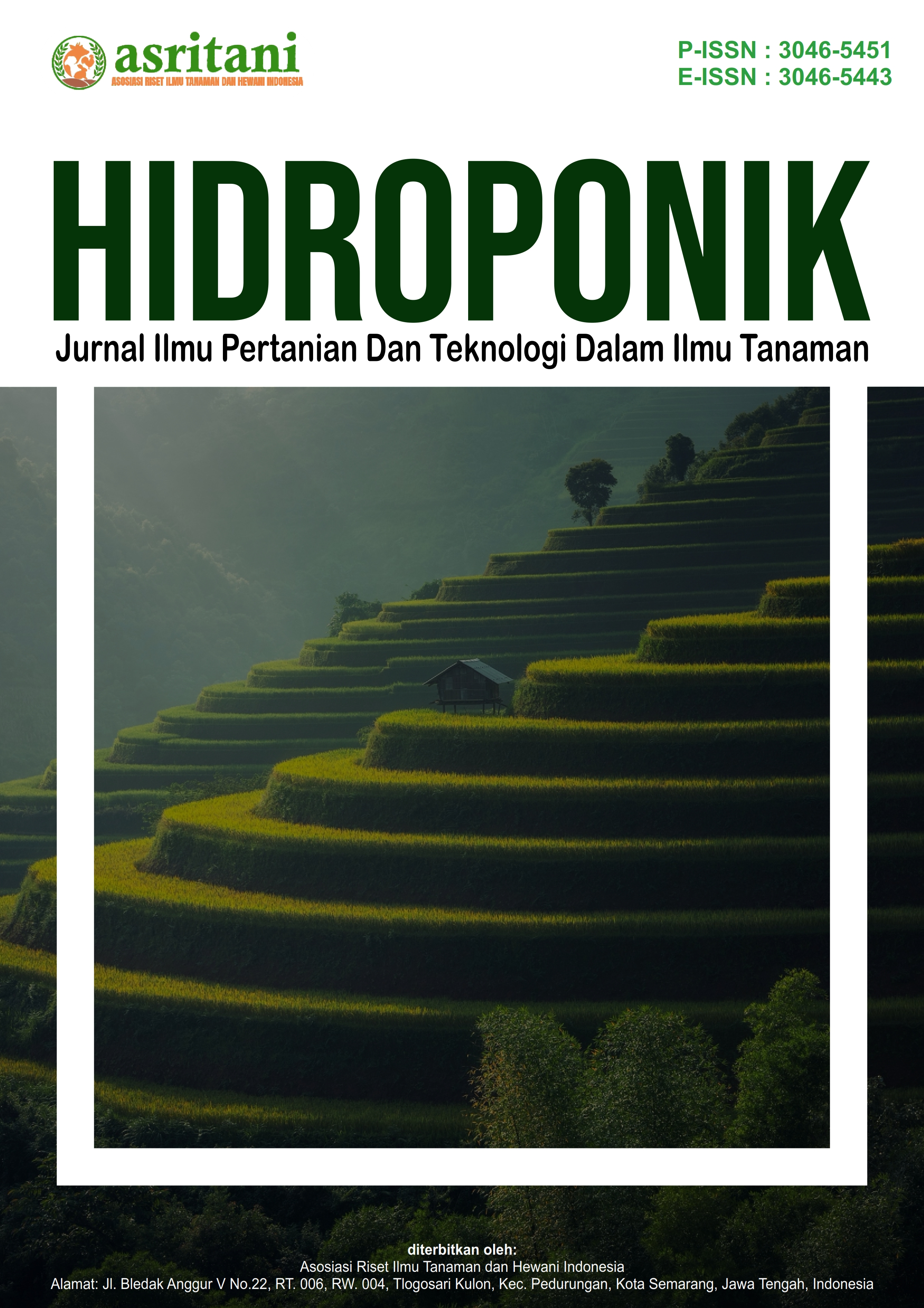Peningkatan Ketahanan Pakcoy terhadap Cekaman Kekeringan Melalui Aplikasi Biochar dan Pupuk Guano
DOI:
https://doi.org/10.62951/hidroponik.v2i1.272Keywords:
Biochar, Guano, Fertilizer, Pakchoy, PlantAbstract
This research aims to determine the effect of using biochar and guano fertilizer on the growth and resistance of pakcoy to drought stress and it is hoped that this research will add information for the development of pakcoy plant cultivation techniques that are more adaptive to dry land. The method used in this research was a 2 factorial completely randomized plan. The first factor is providing Biochar (B) which consists of 4 levels: B0= Control 0 tons/ha, B2= Biochar 5 tons/ha, B3= Biochar 10 tons/ha, B4= Biochar 15 tons/ha. The second factor is the application of Guano fertilizer (G) which consists of 4 levels: G0= control 0 tons/ha, G2= Guano 5 tons/ha, G3= Guano 10 tons/ha, G4= Guano 15 tons/ha. . Based on the level of treatment used, 16 combinations were obtained, BOGO, BOG2, BOG3, BOG4, B2GO, B2G2, B2G3, B2G4, B3GO, B3G2, B3G3, B3G4, B4GO, B4G2, B4G3, B4G4, which were repeated 3 times so that there were 48 experimental units. The parameters observed include plant height, number of leaves and stem diameter. The results of the research showed that there was an interaction between plant height at 7 dap, 14 dap, 21 dap, 28 dap, number of leaves at 7 dap, 14 dap, 21 dap and stem diameter at 14 dap and 28 dap. Treatment with biochar rates of 10 tons/ha, 15 tons/ha and guano fertilizer 10 tons/ha, 15 tons/ha gave good growth results in plant height, number of leaves and stem diameter. This combination of two treatments can increase the efficiency of good nutrient uptake for optimal vegetative plant growth and can increase the soil's capacity to retain air and nutrients, while guano fertilizer provides essential nutrients that support the development of pak choy plants.
References
Alianti, Y., Zubaidah, S., & Saraswati, D. (2016). Tanggapan tanaman tomat (Lycopersicum esculentum Mill.) terhadap pemberian biochar dan pupuk hayati pada tanah gambut. Skripsi. Jurusan Budidaya Pertanian, Fakultas Pertanian, Universitas Palangka Raya, Kalimantan Tengah.
Benggu, Y. I., Gea, S. S., Ishaq, L. F., & Tae, A. S. J. A. (2021). Pengaruh aplikasi biochar dan mikoriza terhadap ketahanan cekaman kekeringan dan hasil tanaman jagung manis (Zea mays saccharata Sturt). Agrisa, 10(1), 1-16.
Danapriatna, N. (2010). Pengaruh cekaman kekeringan terhadap serapan nitrogen dan pertumbuhan tanaman. Jurnal Ilmu Pertanian, 12(3), 45-52.
Gaskin, J. W., et al. (2008). The impact of biochar on the agronomic performance of crops. Soil Science Society of America Journal, 72(3), 915-924.
Glaser, B., Lehmann, J., & Zech, W. (2002). Ameliorating physical and chemical properties of highly weathered soils in the tropics with biochar. Biology and Fertility of Soils, 35(4), 219-230.
Glaser, B., Lehmann, J., & Zech, W. (2002). Amelioration of soil fertility with biochar. Journal of Applied Soil Ecology, 19(1), 1-15.
Hadi, W., Prasetyo, B. H., & Sugiarto, Y. (2021). Efektivitas pupuk guano dalam meningkatkan pertumbuhan tanaman hortikultura. Jurnal Ilmu Tanah dan Agroklimatologi, 18(2), 112-125.
Hidayat, I., Hadi, H., & Subiyantoro, A. (2020). Pengaruh pupuk guano terhadap pertumbuhan dan produksi tanaman cabai. Jurnal Agroteknologi, 15(3), 143-151.
Husain, S., Mubeen, M., Ahmad, A., & Wajid, A. (2018). Physiological responses of wheat (Triticum aestivum L.) to drought stress. International Journal of Agriculture and Biology, 20(1), 133-139.
Lehmann, J., & Joseph, S. (2015). Biochar for environmental management: Science, technology, and implementation. Routledge.
Lehmann, J., Rillig, M. C., Thies, J., Masiello, C. A., Hockaday, W. C., & Crowley, D. (2006). Biochar effects on soil biota–A review. Soil Biology and Biochemistry, 38(9), 1835-1851.
Makoto, T., Nakahara, M., & Takahashi, H. (2015). Influence of biochar application on nutrient cycling and plant growth in different soil types. Agronomy Journal, 107(5), 1712-1722.
Mathobo, R., Marais, D., & Steyn, J. M. (2017). The effect of drought stress on yield, leaf gaseous exchange and chlorophyll fluorescence of dry beans (Phaseolus vulgaris L.). Agricultural Water Management, 180, 118-125.
Mutryarny, E., & Lidar, S. (2018). Respon tanaman pakcoy (Brassica rapa L.) akibat pemberian zat pengatur tumbuh hormonik. Jurnal Ilmiah Pertanian, 14(2), 29-34.
Pereira, M. S., Tuas, M. A., & Jehalu, A. R. (2023). Efek uji residu kompos biochar dan irigasi tetes terhadap pertumbuhan serta hasil tanaman pakcoy (Brassica rapa L.). Jurnal Agrokompleks, 12(2), 103-115.
Tama, S. A. (2018). Pengaruh aplikasi biochar dan tingkat cekaman air terhadap pertumbuhan dan hasil tanaman sawi pakcoy (Brassica rapa L.) pada tanah pasiran. Skripsi. Universitas Jember.
Thomas, D. S. G., & Benson, D. (2010). Guano and its use in agriculture. Journal of Applied Ecology, 47(2), 305-313.
Wibowo, W. A., Hariyono, B., & Kusuma, Z. (2016). Pengaruh biochar, abu ketel dan pupuk kandang terhadap pencucian nitrogen tanah berpasir Asembagus, Situbondo. Jurnal Tanah dan Sumberdaya Lahan, 3(1), 269-278.
Zhang, X., et al. (2012). The effects of biochar application on soil properties and crop yield: A meta-analysis. Agricultural Systems, 108, 1-10.
Zhang, X., Wang, H., He, L., Lu, K., Sarmah, A., Li, J., ... & Huang, H. (2019). Using biochar for remediation of soils contaminated with heavy metals and organic pollutants. Environmental Science and Pollution Research, 26(5), 4028-4035.
Downloads
Published
How to Cite
Issue
Section
License
Copyright (c) 2025 Hidroponik : Jurnal Ilmu Pertanian Dan Teknologi Dalam Ilmu Tanaman

This work is licensed under a Creative Commons Attribution-ShareAlike 4.0 International License.





